Applied Mathematics
Vol. 3 No. 4 (2012) , Article ID: 18878 , 6 pages DOI:10.4236/am.2012.34049
Blow-Up Phenomena for a Class of Parabolic Systems with Time Dependent Coefficients
1Department of Mathematics, Cornell University, Ithaca, USA
2Département de Mathématiques et de Statistique, Université Laval, Québec City, Canada
Email: gphilip@mat.ulaval.ca
Received February 8, 2012; revised March 7, 2012; accepted March 14, 2012
Keywords: Parabolic Systems; Blow-Up; Sobolev Type Inequality
ABSTRACT
Blow-up phenomena for solutions of some nonlinear parabolic systems with time dependent coefficients are investigated. Both lower and upper bounds for the blow-up time are derived when blow-up occurs.
1. Introduction
It is well known that the solutions of parabolic problems may remain bounded for all time, or may blow-up in finite or infinite time. When blow-up occurs at time , the evaluation of
, the evaluation of ![]() is of great practical interest.
is of great practical interest.
In a recent paper [1] Payne and Schaefer have investigated the blow-up phenomena of solutions in some parabolic systems of equations under homogeneous Dirichlet boundary conditions. The contribution of this note is to extend their investigations to a class of parabolic systems with time dependent coefficients. The case of a single parabolic equation was investigated recently in [2].
There is an abounding literature dealing with blow-up phenomena of solutions to parabolic partial differential equations. We refer the interested readers to [3-5]. A variety of physical, chemical, biological applications are discussed in [5,6]. Further references to the field are [1,7-19]. In this note we investigate the blow-up phenomena of the solution  of the following parabolic system
of the following parabolic system
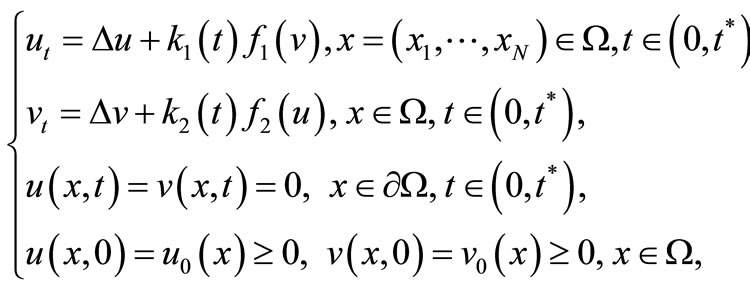 (1.1)
(1.1)
where  is a bounded domain in
is a bounded domain in . The initial data
. The initial data  as well as the data
as well as the data 
 are assumed nonnegative, so that the solution
are assumed nonnegative, so that the solution  of (1.1) will be nonnegative by the maximum principle. More specific assumptions on the data will be made later.
of (1.1) will be nonnegative by the maximum principle. More specific assumptions on the data will be made later.
In Section 2 we derive conditions on the data of problem (1.1) sufficient to guarantee that blow-up will occur, and derive under these conditions some upper bound for![]() . In Section 3 we derive some lower bounds for the blow-up time
. In Section 3 we derive some lower bounds for the blow-up time ![]() when blow-up occurs. However this section is limited to the case of
when blow-up occurs. However this section is limited to the case of  in
in  and in
and in  respectively, because our technique makes use of some Sobolev type inequalities available in
respectively, because our technique makes use of some Sobolev type inequalities available in  and in
and in  only. For convenience we include the proof of one of these inequalities in Section 4.
only. For convenience we include the proof of one of these inequalities in Section 4.
2. Conditions for Blow-Up in Finite Time t*
Let  be the first eigenvalue and
be the first eigenvalue and ![]() be the associated eigenfunction of the Dirichlet-Laplace operator defined as
be the associated eigenfunction of the Dirichlet-Laplace operator defined as
 (2.1)
(2.1)
 (2.2)
(2.2)
Let the auxiliary function  be defined in
be defined in  as
as
 (2.3)
(2.3)
with
 (2.4)
(2.4)
where  is the solution of problem (1.1). We assume in this section that
is the solution of problem (1.1). We assume in this section that  is a bounded domain of
is a bounded domain of , and that
, and that
 (2.5)
(2.5)
 (2.6)
(2.6)
We then compute
 (2.7)
(2.7)
Making use of Hölder’s inequality, we have
 (2.8)
(2.8)
Combining (2.7) and (2.8), we obtain
 (2.9)
(2.9)
A similar computation leads to
 (2.10)
(2.10)
Adding (2.9) and (2.10), we obtain
 (2.11)
(2.11)
where  is defined in (2.6). We first investigate the particular case
is defined in (2.6). We first investigate the particular case . Making use of Hölder’s inequality, we have
. Making use of Hölder’s inequality, we have
 (2.12)
(2.12)
Inserted in (2.11), we obtain the first order differential inequality
 (2.13)
(2.13)
Integrating (2.13) from 0 to , we obtain the inequality
, we obtain the inequality
 (2.14)
(2.14)
Suppose that the data satisfy the condition
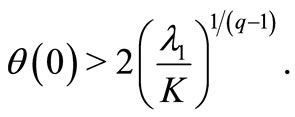 (2.15)
(2.15)
Then  vanishes at some time
vanishes at some time , and
, and  must blow up at some time
must blow up at some time . We obtain
. We obtain
 (2.16)
(2.16)
In the general case, we suppose without loss of generality that , and make use of the inequality
, and make use of the inequality
 (2.17)
(2.17)
valid for arbitrary . Choosing
. Choosing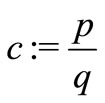 , we obtain
, we obtain
 (2.18)
(2.18)
with
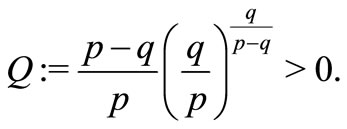 (2.19)
(2.19)
Inserted in (2.12), we obtain the first order differential inequality
 (2.20)
(2.20)
Suppose that the initial data are so large that  . Then
. Then  is increasing for t small. Since
is increasing for t small. Since  is increasing in
is increasing in  from its negative minimum, it follows then that
from its negative minimum, it follows then that  is increasing for
is increasing for . This shows that
. This shows that  remains positive, so that
remains positive, so that  blows up at time
blows up at time![]() . Integrating (2.20) leads to the following upper bound for
. Integrating (2.20) leads to the following upper bound for ![]()
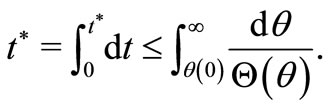 (2.21)
(2.21)
These results are summarized in the following.
Theorem 1
1) Assume (2.5) with , (2.6), and (2.15). Then
, (2.6), and (2.15). Then  defined in (2.3) blows up at finite time
defined in (2.3) blows up at finite time ![]() bounded above by (2.16).
bounded above by (2.16).
2) Assume (2.5) with , (2.6), and
, (2.6), and  with
with  defined in (2.20). Then
defined in (2.20). Then  blows up at finite time
blows up at finite time ![]() bounded above by (2.21).
bounded above by (2.21).
To conclude this section, we note that if the condition (2.6) is replaced by
 (2.22)
(2.22)
then we have to replace the initial data  by
by  in Theorem 1. Clearly we may use a lower bound for
in Theorem 1. Clearly we may use a lower bound for . For instance we may integrate the differential inequality
. For instance we may integrate the differential inequality
 (2.23)
(2.23)
that follows from (2.11), leading to the lower bound
 (2.24)
(2.24)
3. Lower Bounds for t*
In this section we assume that the data  satisfy the conditions
satisfy the conditions
 (3.1)
(3.1)
and that the data  are nonnegative for all
are nonnegative for all . Moreover the solution is assumed to blow up in the sense that
. Moreover the solution is assumed to blow up in the sense that  as
as , where
, where  is defined as
is defined as
 (3.2)
(3.2)
with
 (3.3)
(3.3)
 (3.4)
(3.4)
Differentiating (3.3) and making use of (1.1), (3.1), we obtain
 (3.5)
(3.5)
with
![]() (3.6)
(3.6)
Making use of Schwarz and Hölder’s inequalities we have
 (3.7)
(3.7)
In  we make use of the following Sobolev type inequality
we make use of the following Sobolev type inequality
 (3.8)
(3.8)
derived in the last section of the paper. Combining (3.7) and (3.8), we obtain
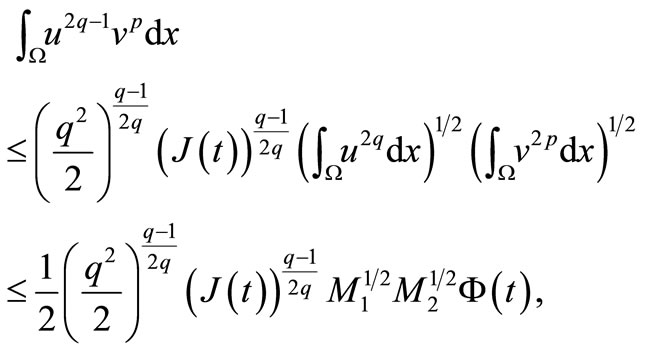 (3.9)
(3.9)
where we have used the arithmetic-geometric mean inequality. Making use of the inequality
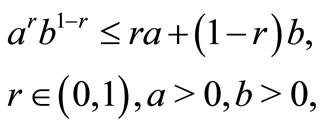 (3.10)
(3.10)
we have
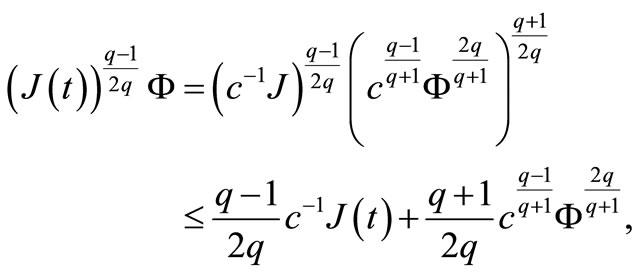 (3.11)
(3.11)
valid for arbitrary  to be chosen later. Inserted in (3.9) and (3.5), we obtain
to be chosen later. Inserted in (3.9) and (3.5), we obtain
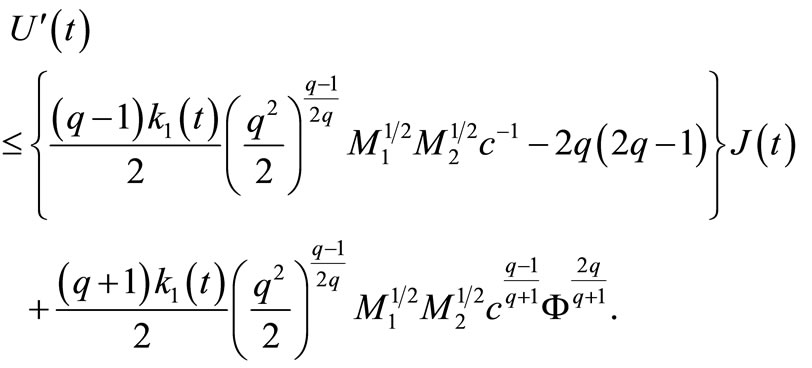 (3.12)
(3.12)
We now select
 (3.13)
(3.13)
in order to have  in (3.12), arriving at
in (3.12), arriving at
 (3.14)
(3.14)
with
 (3.15)
(3.15)
A similar computation leads to
 (3.16)
(3.16)
where  is defined in (3.4). In
is defined in (3.4). In , we replace (3.7) by
, we replace (3.7) by
 (3.17)
(3.17)
and make use of the Sobolev type inequality
 (3.18)
(3.18)
derived by Talenti in [20] with . Inserted in (3.17), we obtain
. Inserted in (3.17), we obtain
 (3.19)
(3.19)
with
 (3.20)
(3.20)
Moreover we make use of (3.10) to write
 (3.21)
(3.21)
with arbitrary  to be chosen later. Combining (3.5), (3.19) and (3.21), we obtain
to be chosen later. Combining (3.5), (3.19) and (3.21), we obtain

We now select ![]() such that the quantity
such that the quantity  in (3.22) vanishes. We are then led to the inequality
in (3.22) vanishes. We are then led to the inequality
 (3.23)
(3.23)
with
 (3.24)
(3.24)
Finally we make use of (3.10) to write
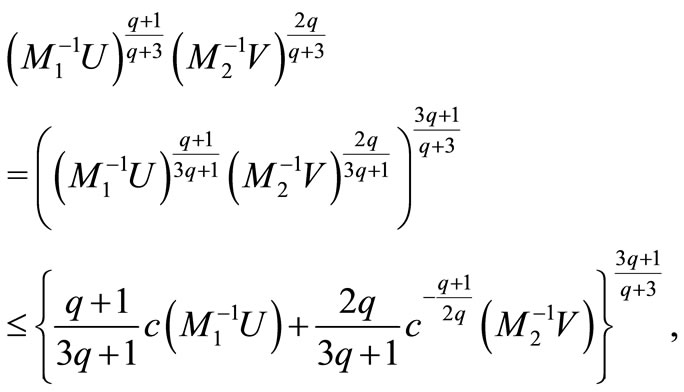 (3.25)
(3.25)
and select ![]() to satisfy
to satisfy , leading to
, leading to
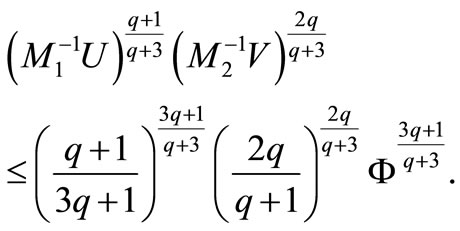 (3.26)
(3.26)
Inserted in (3.23), we obtain
 (3.27)
(3.27)
with
 (3.28)
(3.28)
A similar computation leads to
 (3.29)
(3.29)
If we suppose that
 (3.30)
(3.30)
then there exists  such that
such that  and we have
and we have
 (3.31)
(3.31)
valid for , with
, with
 (3.32)
(3.32)
 (3.33)
(3.33)
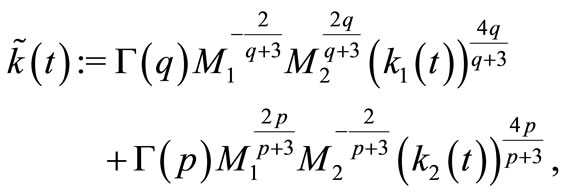 (3.34)
(3.34)
Integrating (3.31), we obtain in the two-dimensional case
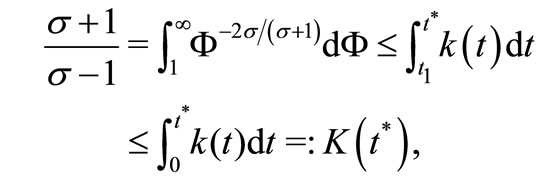 (3.35)
(3.35)
from which we obtain a lower bound for ![]() of the form
of the form
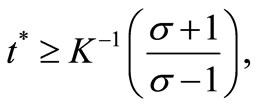 (3.36)
(3.36)
where  is the inverse function of
is the inverse function of . In the threedimensional case, we obtain
. In the threedimensional case, we obtain
 (3.37)
(3.37)
from which we obtain a lower bound for ![]() of the form
of the form
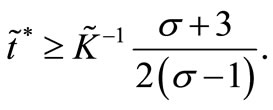 (3.38)
(3.38)
These results are summarized in the following
Theorem 2
Under the assumption (3.30), a lower bound for the blow-up time t* of the solution  of (1.1) is given by (3.36) in the two-dimensional case and by (3.38) in the three-dimensional case.
of (1.1) is given by (3.36) in the two-dimensional case and by (3.38) in the three-dimensional case.
In the particular case in which  and
and  are constant, we have
are constant, we have
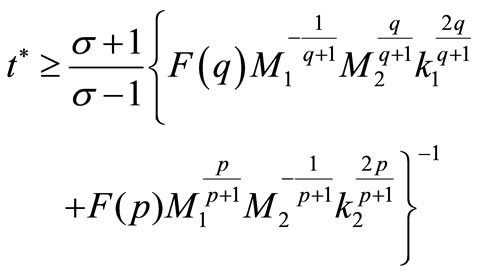 (3.39)
(3.39)
in the two-dimensional case and
 (3.40)
(3.40)
in the three-dimensional case.
Theorem 2 could easily be extended to systems of n parabolic equations of the form
 (3.41)
(3.41)
4. Sobolev Type Inequality in 
The Sobolev type inequality (3.8) in  may be known, but for the convenience of the reader we present a proof here.
may be known, but for the convenience of the reader we present a proof here.
Lemma 1
Let  be a nonnegative piecewise
be a nonnegative piecewise  -function defined in a bounded domain
-function defined in a bounded domain  that vanishes on the boundary
that vanishes on the boundary . Let
. Let  be any constant
be any constant . Then we have the following Sobolev type inequality
. Then we have the following Sobolev type inequality
 (4.1)
(4.1)
valid for .
.
For the proof of (4.1), we follow the argument of Payne in [21]. We note that (4.1) is equivalent to
 (4.2)
(4.2)
where  is the convex hull of
is the convex hull of , and
, and
 It is therefore sufficient to establish (4.1) for
It is therefore sufficient to establish (4.1) for  convex. For the proof, let
convex. For the proof, let  be an arbitrary point in
be an arbitrary point in  Let
Let  be two pairs of boundary points associated to P with
be two pairs of boundary points associated to P with
 . Since
. Since ![]() vanishes on
vanishes on , we have for any constant
, we have for any constant 
 (4.3)
(4.3)
from which we obtain
 (4.4)
(4.4)
Similarly we have
 (4.5)
(4.5)
Multiplying (4.4) by (4.5) and integrating over  leads to
leads to

 (4.6)
(4.6)
which is the desired inequality (4.1). We note that we have used the Schwarz and the arithmetic-geometric mean inequalities in the two last steps of (4.6).
REFERENCES
- L. E. Payne and P. W. Schaefer, “Blow-Up Phenomena for Some Nonlinear Parabolic Systems,” International Journal of Pure and Applied Mathematics, Vol. 48, No. 2, 2008, pp. 193-202.
- L. E. Payne and G. A. Philippin, “On Blow-Up Phenomena for Solutions of a Class of Nonlinear Parabolic Problems with Time Dependent Coefficients under Dirichlet Boundary Conditions,” Proceedings of the American Mathematical Sociery, accepted.
- V. A. Galaktionov and J. L. Vazquez, “The Problem of Blow-Up in Nonlinear Parabolic Equations,” Journal of Dynamical and Control System, Vol. 8, No. 3, 2002, pp. 399-433. doi:10.1023/A:1016334621818
- A. A. Samarskii, V. A. Galaktionov, S. P. Kurdyumov and A. P. Mikhailov, “Blow-up in quasilinear parabolic equations,” Walter de Gruyter & Co., Berlin, 1995. doi:10.1515/9783110889864
- B. Straughan, “Explosive Instabilities in Mechanics,” Springer, Berlin, 1998. doi:10.1007/978-3-642-58807-5
- C. Bandle and H. Brunner, “Blow-Up in Diffusion Equations: A Survey,” Journal of Computational and Applied Mathematics, Vol. 97, No. 1-2, 1998, pp. 3-22. doi:10.1016/S0377-0427(98)00100-9
- L. E. Payne, G. A. Philippin and P. W. Schaefer, “Bounds for Blow-Up Time in Nonlinear Parabolic Problems,” Journal of Mathematical Analysis and Applications, Vol. 338, No. 1, 2008, pp. 438-447. doi:10.1016/j.jmaa.2007.05.022
- L. E. Payne, G. A. Philippin and P. W. Schaefer, “BlowUp Phenomena for Some Nonlinear Parabolic Problems,” Nonlinear Analysis: Theory, Methods & Applications, Vol. 69, No. 10, 2008, pp. 3495-3502. doi:10.1016/j.na.2007.09.035
- L. E. Payne, G. A. Philippin and S. Vernier-Piro, “BlowUp Phenomena for a Semilinear Heat Equation with Nonlinear Boundary Condition, I,” Zeitschrift für Angewandte Mathematik und Physik, Vol. 61, No. 6, 2010, pp. 999- 1007. doi:10.1007/s00033-010-0071-6
- L. E. Payne, G. A. Philippin and S. Vernier-Piro, “BlowUp Phenomena for a semilinear Heat Equation with Nonlinear Boundary Condition, II,” Nonlinear Analysis: Theory, Methods & Applications, Vol. 73, No. 4, 2010, pp. 971-978. doi:10.1016/j.na.2010.04.023
- L. E. Payne and P. W. Schaefer, “Lower Bound for BlowUp Time in Parabolic Problems under Neumann Conditions,” Applicable Analysis, Vol. 85, No. 10, 2006, pp. 1301-1311. doi:10.1080/00036810600915730
- L. E. Payne and P. W. Schaefer, “Lower Bound for Blow -Up Time in Parabolic Problems under Dirichlet Conditions,” Journal of Mathematical Analysis and Applications, Vol. 328, No. 2, 2007, pp. 1196-1205. doi:10.1016/j.jmaa.2006.06.015
- L. E. Payne and P. W. Schaefer, “Bounds for the BlowUp Time for the Heat Equation under Nonlinear Boundary Conditions,” Proceedings of the Royal Society of Edinburgh, Vol. 139, No. 6, 2009, pp. 1289-1296.
- L. E. Payne and J. C. Song, “Lower Bounds for the BlowUp Time in a Temperature Dependent Navier-Stokes Flow,” Journal of Mathematical Analysis and Applications, Vol. 335, No. 1, 2007, pp. 371-376. doi:10.1016/j.jmaa.2007.01.083
- P. Quittner, “On Global Existence and Stationary Solutions of Two Classes of Semilinear Parabolic Equations,” Commemtationes Mathematicae Universitatis Carolinae, Vol. 34, No. 1, 1993, pp. 105-124.
- P. Quittner and P. Souplet, “Superlinear Parabolic Problems. Blow-Up, Global Existence and Steady States,” Birkhäuser, Basel, 2007.
- J. L. Vazquez, “The Problem of Blow-Up for Nonlinear Heat Equations. Complete Blow-Up and Avalanche Formation,” Rendiconti Lincei Matematica e Applicazioni, Vol. 15, No. 34, 2004, pp. 281-300.
- F. B. Weissler, “Local Existence and Nonexistence for Semilinear Parabolic Equations in LP,” Indiana University Mathematics Journal, Vol. 29, No. 1, 1980, pp. 79-102. doi:10.1512/iumj.1980.29.29007
- F. B. Weissler, “Existence and Nonexistence of Global Solutions for a Heat Equation,” Israël Journal of Mathematics, Vol. 38, No. 1-2, 1981, pp. 29-40.
- G. Talenti, “Best Constant in Sobolev Inequality,” Annali di Matematica Pura ed Applicata, Vol. 110, No. 1, 1976, pp. 353-372.
- L. E. Payne, “Uniqueness Criteria for Steady State Solutions of the Navier-Stokes Equations,” In: Atti del simposio internazionale sulle applicazioni dell’analisi alla fisica matematica, Cagliari-Sassari, 1964, pp. 130-153.

